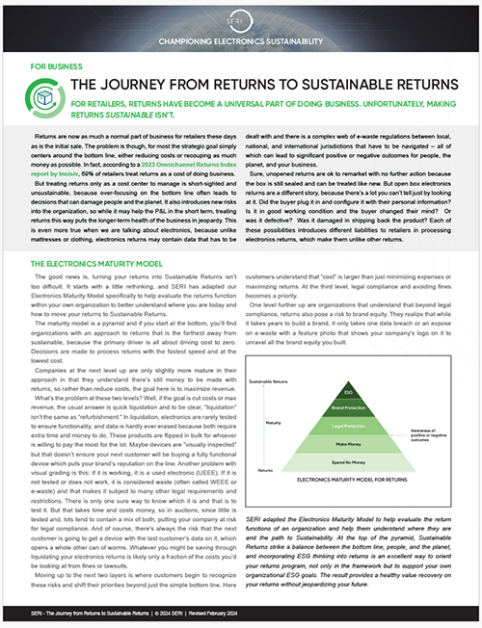For Business
THE JOURNEY FROM RETURNS TO
SUSTAINABLE RETURNS
SUSTAINABLE RETURNS
FOR RETAILERS, RETURNS HAVE BECOME A UNIVERSAL PART OF DOING BUSINESS. UNFORTUNATELY, MAKING RETURNS SUSTAINABLE ISN’T.
Returns are now as much a normal part of business for retailers these days as is the initial sale. The problem is though, for most the strategic goal simply centers around the bottom line, either reducing costs or recouping as much money as possible. In fact, according to a 2023 Omnichannel Returns Index report by Incisiv, 69% of retailers treat returns as a cost of doing business.
But treating returns only as a cost center to manage is short-sighted and unsustainable, because over-focusing on the bottom line often leads to decisions that can damage people and the planet. It also introduces new risks into the organization, so while it may help the P&L in the short term, treating returns this way puts the longer-term health of the business in jeopardy. This is even more true when we are talking about electronics, because unlike mattresses or clothing, electronics returns may contain data that has to be dealt with and there is a complex web of e-waste regulations between local, national, and international jurisdictions that have to be navigated – all of which can lead to significant positive or negative outcomes for people, the planet, and your business.
Sure, unopened returns are ok to remarket with no further action because the box is still sealed and can be treated like new. But open box electronics returns are a different story, because there’s a lot you can’t tell just by looking at it. Did the buyer plug it in and configure it with their personal information? Is it in good working condition and the buyer changed their mind? Or was it defective? Was it damaged in shipping back the product? Each of these possibilities introduces different liabilities to retailers in processing electronics returns, which make them unlike other returns.
Electronics Maturity Model
The good news is, turning your returns into Sustainable Returns isn’t too difficult. It starts with a little rethinking, and SERI has adapted our Electronics Maturity Model specifically to help evaluate the returns function within your own organization to better understand where you are today and how to move your returns to Sustainable Returns.
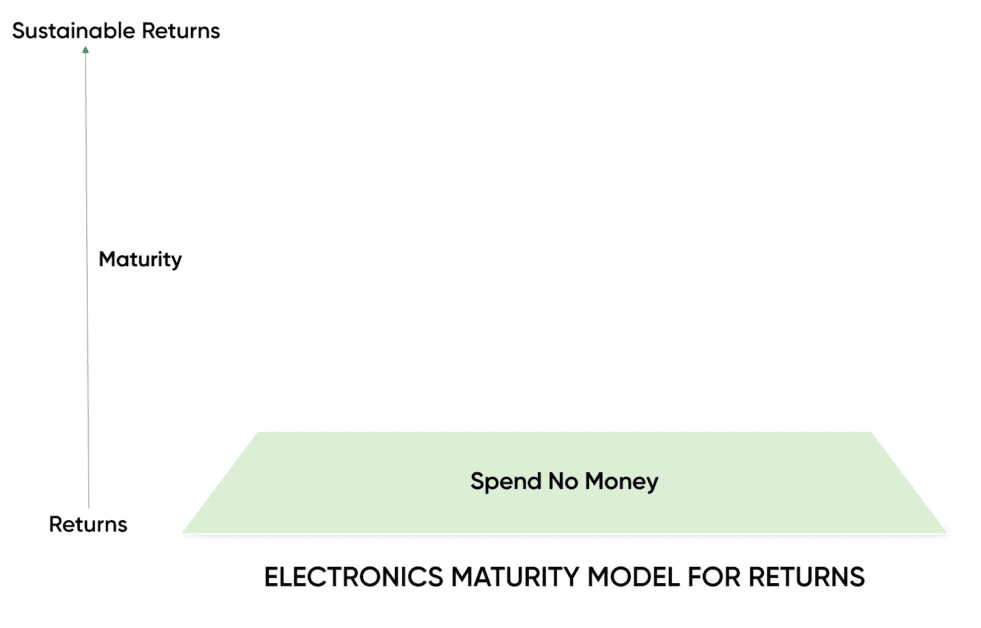
The maturity model is a pyramid and if you start at the bottom, you’ll find organizations with an approach to returns that is the farthest away from sustainable, because the primary driver is all about driving cost to zero. Decisions are made to process returns with the fastest speed and at the lowest cost.
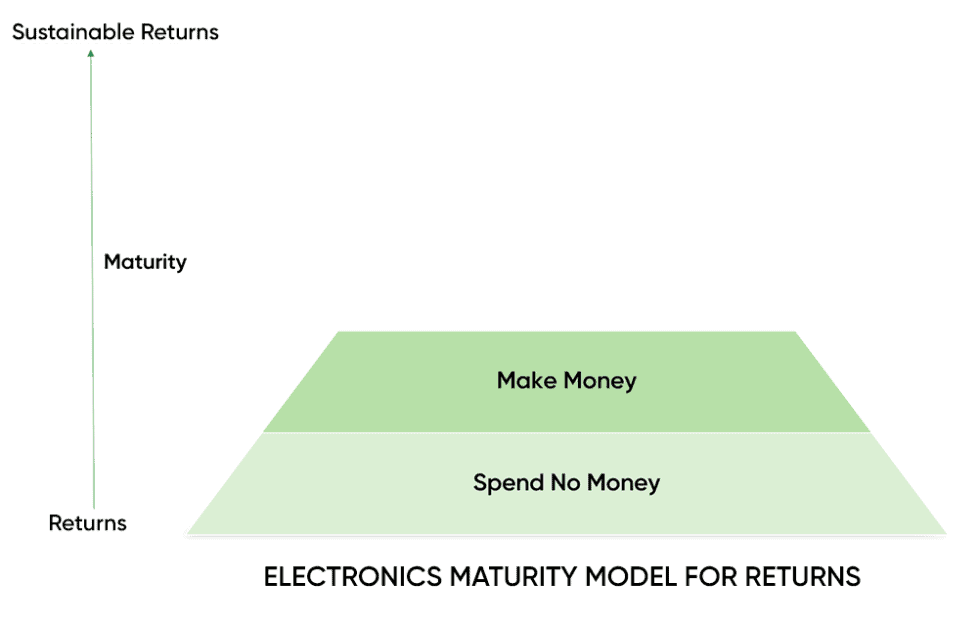
Companies at the next level up are only slightly more mature in their approach in that they understand there’s still money to be made with returns, so rather than reduce costs, the goal here is to maximize revenue.
What’s the problem at these two levels? Well, if the goal is cut costs or max revenue, the usual answer is quick liquidation and to be clear, “liquidation” isn’t the same as “refurbishment.” In liquidation, electronics are rarely tested to ensure functionality, and data is hardly ever erased because both require extra time and money to do. These products are flipped in bulk for whoever is willing to pay the most for the lot. Maybe devices are “visually inspected” but that doesn’t ensure your next customer will be buying a fully functional device which puts your brand’s reputation on the line. Another problem with visual grading is this: if it is working, it is a used electronic (UEEE). If it is not tested or does not work, it is considered waste (often called WEEE or e-waste) and that makes it subject to many other legal requirements and restrictions. There is only one sure way to know which it is and that is to test it. But that takes time and costs money, so in auctions, since little is tested and, lots tend to contain a mix of both, putting your company at risk for legal compliance. And of course, there’s always the risk that the next customer is going to get a device with the last customer’s data on it, which opens a whole other can of worms. Whatever you might be saving through liquidating your electronics returns is likely only a fraction of the costs you’d be looking at from fines or lawsuits.
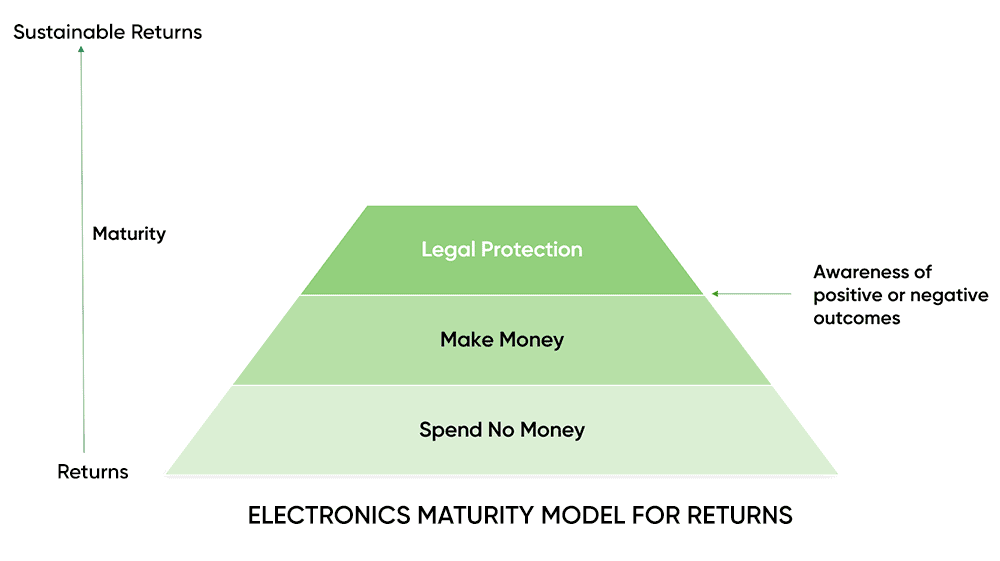
Moving up to the next two layers is where customers begin to recognize these risks and shift their priorities beyond just the simple bottom line. Here customers understand that “cost” is larger than just minimizing expenses or maximizing returns. At the third level, legal compliance and avoiding fines becomes a priority.
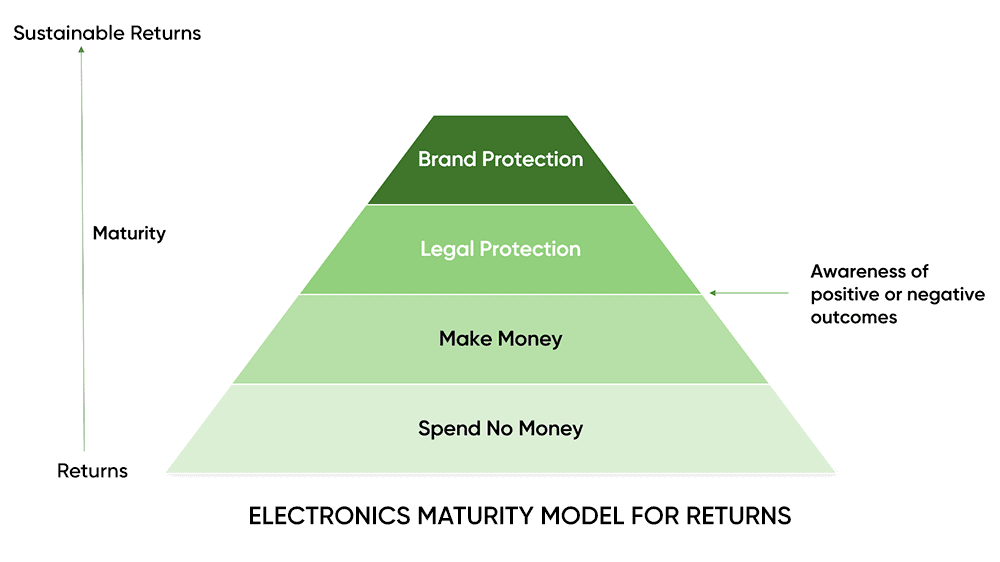
One level further up are organizations that understand that beyond legal compliance, returns also pose a risk to brand equity. They realize that while it takes years to build a brand, it only takes one data breach or an expose on e-waste with a feature photo that shows your company’s logo on it to unravel all the brand equity you built.
Both of these levels of maturity are primarily defensive, guarding against risk. But returns also present opportunity, and this is the approach that organizations at the top of the maturity model take when building their returns program.
Sustainable Returns strikes a balance between the bottom line, people,
and the planet
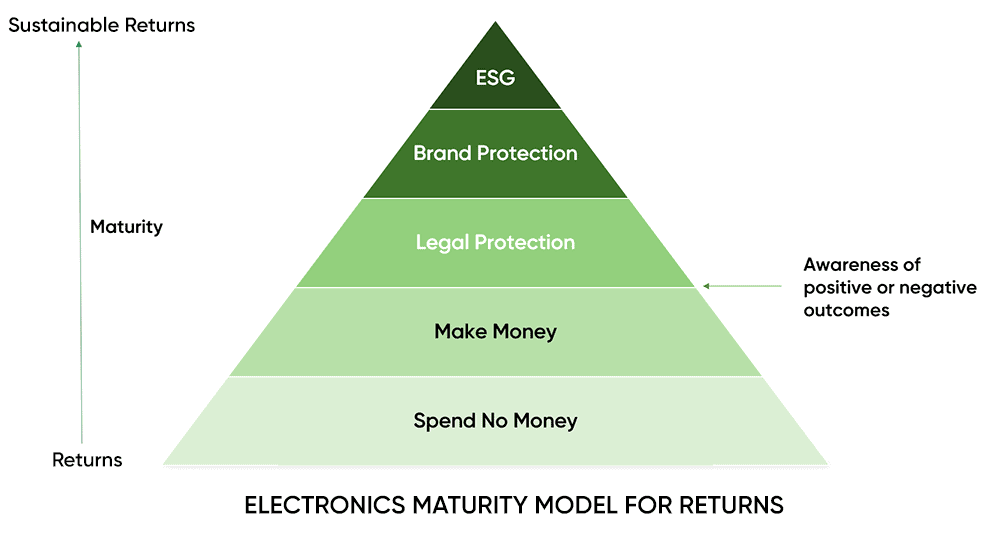
Sustainable Returns strikes a balance between the bottom line, people, and the planet, and incorporating ESG thinking into returns is a good way to orient your returns program, not only in framework, but to support your own organizational ESG goals as well. The result provides a healthy value recovery on your returns without jeopardizing your future. It’s a circular economy that you can create in your own supply chain, and an opportunity to showcase your green business process and your corporate social responsibility. For Sustainable Returns, ask yourself:
What impact does our returns program have on the environment? Are we making sure everything that can be reused is actually being reused, either as whole devices or as components? Are all materials being properly recycled and are all hazardous materials contained? Are we being legally compliant?
What impact does our returns program have on society? Are all devices tested, repaired, and any data wiped? Instead of being destroyed to reduce costs, are returns making it into the hands of people who can put them to good use?
And finally, what governance do we have in place to ensure we’re practicing Sustainable Returns?
This is where who you choose as your partner for electronics returns really matters, because the truth is, not all vendors support Sustainable Returns with their own actions. How do you know who will and who won’t? This is where standards and certifications come into play.
Choosing R2 Certified partners for returns is how you’ll know you have a partner that supports Sustainable Returns. R2 is comprehensive, including best practices for environmental, data, and worker health and safety around electronics reuse and recycling.
It’s built by a multistakeholder group, and facilities are independently audited and certified to ensure adherence to the standard.
At SERI, we like to ask “what if.” What if instead of liquidating customer returns as a cost of doing business, electronics were tested and repaired and then used as replacements for other returns?
What if we harvested parts from returns and used those for repairs or sold them back into the market for others to repair?
And what if we had a partner that supported our Sustainable Returns goals and make returns part of our larger ESG and sustainability goals?
Shifting from returns to Sustainable Returns isn’t just a nice idea – it’s sound business management, and it’s what today’s stakeholders expect businesses to practice.
In summary, here are some practical tips to move your returns to
Sustainable Returns:
Ensure the equipment you are reselling is functional. With electronics, there’s a category of product called “Beyond Economic Recovery” or BER. These are products that cost more to test or repair than can be recovered by reselling a refurbished product, and BER electronics are especially tricky. If it is not cost effective for you to repair, it likely is not cost effective for someone else to do it either, at least not responsibly. Many times, those buying your broken equipment at auctions are not responsibly managing it – they scavenge the salvageable pieces and dump the rest.
Embrace opportunities to test and repair your products and put them back on the market. Quality refurbished products are another market to gain loyal customers.
Harvest parts from BER equipment. Make one good device from four broken devices. Keep good parts to repair other units.
Instead of liquidating everything, put your efforts into sorting returns. Channel repairable products into refurbishment, non-repairable in to parts harvesting, and the rest into recycling. Up-front sorting will help to keep up with the increasing volume of returns and maximize value.
If you are going to liquidate, make sure the buyers are responsible operators. Buyers need to be qualified to protect data, to have the competency, tools, and systems to test and repair the equipment, and to eliminate the trade of BER products to unqualified buyers.

Make sure your returns partners support your Sustainable Returns goals.

